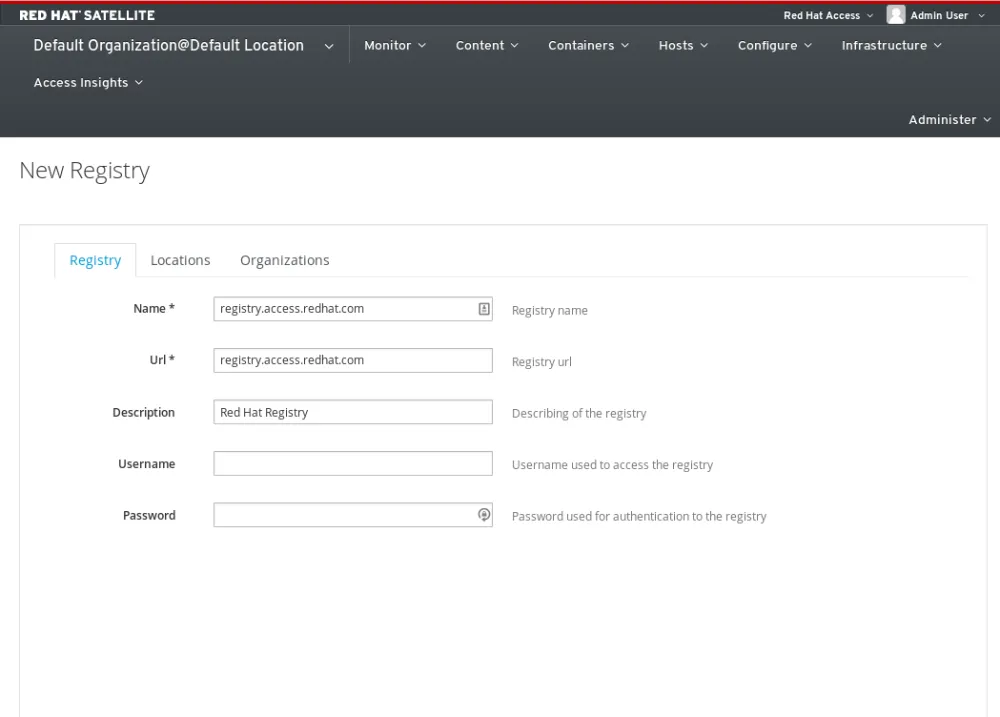This article was originally published on the Red Hat Customer Portal. The information may no longer be current.
One of the first things you will want to do, after coming up to speed with Docker, is probably setup a Registry Server. The Docker project provides a basic Registry Server which people often set up for sharing images in their organization. This is a good starting place, but many organizations quickly outgrow this registry server. Often, administrators and release engineers want more control and better governance around versioning and authentication.
With Satellite 6.1 and the Docker Plugin, this is a snap. The Docker Plugin is installed out of the box and only takes minutes to configure. The Docker plugin is quite flexible and allows a user to consume upstream content from the Red Hat Registry, Docker Hub, and internal Registries. It even allows administrators to pull images from Content View.
Content Views give developers and administrators a way to quickly move Docker images through a controlled Dev/QA/Prod development lifecyle and can even help facilitate a Continuous Integration/Continuous Deployment lifecycle.
Since the Docker plugin leverages the modern design of Satellite 6.1 as a framework, the user is provided with some very desirable capabilities:
- Enterprise on premise registry
- LDAP/AD integration
- Provisioning
- Auditing
- Graphical User Interface (GUI)
- Command Line Interface (CLI) and REST
- Easy to deploy and manage
- Role Based Access Controls (RBAC)
- Security
Quick Walkthrough
The goal of this walk through is to show how with a few commands, you can have an enterprise on premise registry setup and running. This walk through will use Content View and a standard Life Cycle Path with the following workflow:

Add an External Registry Server
First we are going to add a simple external Registry in Satellite. This is a simple pass through. When container hosts are provisioned, they will pull their data directly from the external registry server but everything will be controlled and audited from within Satellite.
For this example, we are going to connect to the official Red Hat Registry, but Satellite can be configured to pull content from any upstream registry server, internal or external. From the web interface, users can even search the external registry for content.
Containers -> Registries -> New Registry

Once added, it will be listed under Registries:
Containers -> Registries

Add a Content View & Life Cycle

Next, let's add all of the necessary data structures within Satellite to leverage Content Views. All of this can be done with just a few commands, making it easy to setup a new Satellite Server.
Leveraging Content Views synchronized data to the Satellite server which simplifies firewall rules and provides a single point of demarcation between the internal and external world:
Create Product & Repo
hammer product create --name='Containers' --organization='Default Organization'
hammer repository create --name='rhel' --organization='Default Organization' --product='Containers' --content-type='docker' --url='https://registry.access.redhat.com' --docker-upstream-name='rhel' --publish-via-http="true"
hammer product synchronize --organization='Default Organization' --name='Containers'
Create Content View, Add Repository & Publish
hammer content-view create --organization='Default Organization' --name "Production Registry" --description "Production Registry"
hammer content-view add-repository --organization "Default Organization" --name "Production Registry" --repository "rhel" --product "Containers"
hammer content-view publish --organization='Default Organization' --name "Production Registry"
Promote Content View
hammer content-view version promote --organization 'Default Organization' --to-lifecycle-environment Development --content-view "Production Registry" --async
hammer content-view version promote --organization 'Default Organization' --to-lifecycle-environment QA --content-view "Production Registry" --async
hammer content-view version promote --organization 'Default Organization' --to-lifecycle-environment Production --content-view "Production Registry" --async
Add a Compute Resource
Now we are going to add a RHEL 7 or RHEL 7 Atomic host to be managed by the Satellite Server. First we need to configure the Docker Daemon to allow remote access to the API. This is not secure, so don't do it in production without restricting access to the Satellite server with firewall rules.
vi /etc/sysconfig/docker
Now modify the OPTIONS Line to look like this. Notice the debug configuration. This is not mandatory but will definitely help if you run into trouble.
OPTIONS='--selinux-enabled -H unix:///var/run/docker.sock -H tcp://0.0.0.0:4243 --debug=true'
Now add the Satellite Servers Certificate
curl http://sat6-rhel7.crunchtools.com/pub/katello-server-ca.crt > /etc/pki/ca-trust/source/anchors/katello-server-ca.crt
update-ca-trust
Now create the compute resource in Satellite
hammer compute-resource create --organizations 'Default Organization' --locations 'Default Location' --provider docker --name atomic7.crunchtools.com --url http://atomic7.crunchtools.com:4243
You are now done with all of the configuration. Let's get on to deploying containers!
Provision Containers
In this section we are going to demonstrate how to provision a container from DockerHub, an External Registry Server and from a Content View. It is important to understand that when provisioning from DockerHub or an external Registry, the container will be deployed with the content directly from the upstream registry server. There is no temporal control (aka snapshot) of the content.
DockerHub -> Satellite -> Container
External Registry -> Satellite -> Container
With a Content View, you can still pull content from an upstream registry server, but you have the advantage of finer grained control over which images can be deployed where. You can have newer versions of the same repository in Development and QA, with fully tested versions in Production. With Satellite you get all of this in a single server.
At first, you might say to yourself, well I can do that with Docker Tags right? While life cycle management could be done with good policy and Docker Tags, Content Views provide the technical controls and adhere to the principals of infrastructure as code. Administrators control which versions of a repository are available instead of relying on easily outdated documentation.
Users can't pull newer or older versions by mistake. In fact the administrator has complete control over which sets of data container hosts receive based solely on the URL they connect to. As will be seen later in the Docker Tags section, there are separate unique URLS for Development, QA and Production. This is very convenient when coordinating between developer's laptops and server running in production.
In the following example, the Satellite server is really acting like three different registry servers (Development/QA/Production).
DockerHub -> Satellite (Development -> QA -> Production) -> Container
External Registry -> Satellite (Development -> QA -> Production) -> Container
OK, now that you understand the concepts, let's get started....
Provision a Container From Docker Hub
This pulls the latest Fedora image from the upstream Docker.io Registry server:
hammer docker container create \
--organizations 'Default Organization' \
--locations 'Default Location' \
--compute-resource atomic7.crunchtools.com \
--repository-name docker.io/fedora \
--tag latest \
--name fedoratest \
--command bash
Provision Container from External Registry
OK, now it's time to provision a container from the external registry server we created:
hammer docker container create \
--organizations 'Default Organization' \
--locations 'Default Location' \
--compute-resource atomic7.crunchtools.com \
--registry-id 1 \
--repository-name rhel \
--tag latest \
--name bashtest \
--command bash
Provision Container from Content View
Now it's time to show the real power of Satellite Server. From the web interface, at step two, you simply select the Content View you want to deploy from.
Containers -> New Container
When deploying from the command line we must first get the URL of the repository we want to pull from. In this case we are going to pull the "rhel" repository from the Production life Cycle Environment:
hammer repository info --id `hammer repository list --content-type docker --organization 'Default Organization' --content-view "Production Registry" --environment Production | grep docker | grep rhel | awk '{print $1}'`
The output looks like the following. Notice the piece of information we are after is the "Published At:" section. We are going to use the default_organization-production-production_registry-containers-rhel portion to provision the container from within Satellite, but developers can use the full URL when pulling images down to their laptops!
ID: 18
Name: rhel
Label: rhel
Organization: Default Organization
Red Hat Repository: no
Content Type: docker
URL:
Publish Via HTTP: yes
Published At: sat6-rhel7.crunchtools.com:5000/default_organization-production-production_registry-containers-rhel
Product:
ID: 3
Name: Containers
GPG Key:
Sync:
Status:
Created: 2015/07/07 19:42:54
Updated: 2015/07/07 19:42:54
Content Counts:
Docker Images: 6
Docker Tags: 7
And voila, we can provision any tag we want from the Production Version of the Content View. This is very powerful in allowing developers to pull the same controlled content that is in production.
hammer docker container create \
--organizations 'Default Organization' \
--locations 'Default Location' \
--compute-resource atomic7.crunchtools.com \
--repository-name "default_organization-production-production_registry-containers-rhel" \
--tag "7.1-9" \
--name rhelcvtest3 \
--command bash
List Containers
Now list the containers that were created
hammer docker container list
scotttest2 | rhel | latest | bash | atomic7.crunchtools.com
bashtest | rhel | latest | bash | atomic7.crunchtools.com
fedoratest | docker.io/fedora | latest | bash | atomic7.crunchtools.com
rhelcvtest | rhel | latest | bash | atomic7.crunchtools.com
rhelcontentviewtest | default_organization-production-production_registry-containers-rhel | 7.1-6 | bash | atomic7.crunchtools.com
rhelcvtest2 | default_organization-production-production_registry-containers-rhel | latest | bash | atomic7.crunchtools.com
rhelcvtest3 | default_organization-production-production_registry-containers-rhel | 7.1-9 | bash | atomic7.crunchtools.com
Docker Tags
One final really cool feature is the Docker Tags page. From this page administrators and developers can list all of the docker tags and associated URLs. Notice the Published At column. Administrators can share these URLs so that users can pull certain versions of content directly to their laptops for development and testing.
From within the web interface:
Content -> Docker Tags

Conclusion
We demonstrated how easy it is to deploy an on premise, enterprise registry server with Red Hat Satellite 6.1 and the Docker plugin. Workflows are quick and easy to setup with a powerful command line interface (CLI). The choice of the CLI or web interface makes it easy to provision and manage containers long term. The foundations provided in this article will arm administrators, release engineers, and developers with workflows they can rely on for years to come.
Future articles will go deeper into how to build a production ready workflow between developers and systems administrators.
Sobre el autor
At Red Hat, Scott McCarty is Senior Principal Product Manager for RHEL Server, arguably the largest open source software business in the world. Focus areas include cloud, containers, workload expansion, and automation. Working closely with customers, partners, engineering teams, sales, marketing, other product teams, and even in the community, he combines personal experience with customer and partner feedback to enhance and tailor strategic capabilities in Red Hat Enterprise Linux.
McCarty is a social media start-up veteran, an e-commerce old timer, and a weathered government research technologist, with experience across a variety of companies and organizations, from seven person startups to 20,000 employee technology companies. This has culminated in a unique perspective on open source software development, delivery, and maintenance.
Más como éste
Registration is now open for Red Hat Summit 2026
Red Hat names Kevin Kennedy as global leader for the Red Hat partner ecosystem
Technically Speaking | Build a production-ready AI toolbox
AI Is Changing The Threat Landscape | Compiler
Navegar por canal
Automatización
Las últimas novedades en la automatización de la TI para los equipos, la tecnología y los entornos
Inteligencia artificial
Descubra las actualizaciones en las plataformas que permiten a los clientes ejecutar cargas de trabajo de inteligecia artificial en cualquier lugar
Nube híbrida abierta
Vea como construimos un futuro flexible con la nube híbrida
Seguridad
Vea las últimas novedades sobre cómo reducimos los riesgos en entornos y tecnologías
Edge computing
Conozca las actualizaciones en las plataformas que simplifican las operaciones en el edge
Infraestructura
Vea las últimas novedades sobre la plataforma Linux empresarial líder en el mundo
Aplicaciones
Conozca nuestras soluciones para abordar los desafíos más complejos de las aplicaciones
Virtualización
El futuro de la virtualización empresarial para tus cargas de trabajo locales o en la nube
